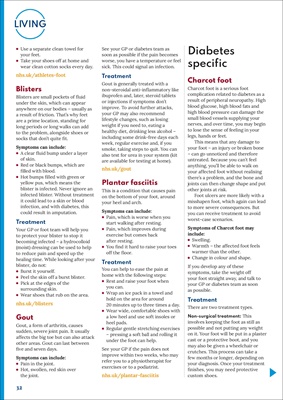
32
LIVING
Use a separate clean towel for
your feet.
Take your shoes off at home and
wear clean cotton socks every day.
nhs.uk/athletes-foot
Blisters
Blisters are small pockets of fluid
under the skin, which can appear
anywhere on our bodies - usually as
a result of friction. That's why feet
are a prime location, standing for
long periods or long walks can add
to the problem, alongside shoes or
socks that don't quite fit.
Symptoms can include:
A clear fluid bump under a layer
of skin.
Red or black bumps, which are
filled with blood.
Hot bumps filled with green or
yellow pus, which means the
blister is infected. Never ignore an
infected blister. Without treatment
it could lead to a skin or blood
infection, and with diabetes, this
could result in amputation.
Treatment
Your GP or foot team will help you
to protect your blister to stop it
becoming infected - a hydrocolloid
(moist) dressing can be used to help
to reduce pain and speed up the
healing time. While looking after your
blister, do not:
Burst it yourself.
Peel the skin off a burst blister.
Pick at the edges of the
surrounding skin.
Wear shoes that rub on the area.
nhs.uk/blisters
Gout
Gout, a form of arthritis, causes
sudden, severe joint pain. It usually
affects the big toe but can also attack
other areas. Gout can last between
five and seven days.
Symptoms can include:
Pain in the joint.
Hot, swollen, red skin over
the joint.
See your GP or diabetes team as
soon as possible if the pain becomes
worse, you have a temperature or feel
sick. This could signal an infection.
Treatment
Gout is generally treated with a
non-steroidal anti-inflammatory like
ibuprofen and, later, steroid tablets
or injections if symptoms don't
improve. To avoid further attacks,
your GP may also recommend
lifestyle changes, such as losing
weight if you need to, eating a
healthy diet, drinking less alcohol -
including some drink-free days each
week, regular exercise and, if you
smoke, taking steps to quit. You can
also test for urea in your system (kit
are available for testing at home).
nhs.uk/gout
Plantar fasciitis
This is a condition that causes pain
on the bottom of your foot, around
your heel and arch.
Symptoms can include:
Pain, which is worse when you
start walking after resting.
Pain, which improves during
exercise but comes back
after resting.
You find it hard to raise your toes
off the floor.
Treatment
You can help to ease the pain at
home with the following steps:
Rest and raise your foot when
you can.
Wrap an ice pack in a towel and
hold on the area for around
20 minutes up to three times a day.
Wear wide, comfortable shoes with
a low heel and use soft insoles or
heel pads.
Regular gentle stretching exercises
- pressing a soft ball and rolling it
under the foot can help.
See your GP if the pain does not
improve within two weeks, who may
refer you to a physiotherapist for
exercises or to a podiatrist.
nhs.uk/plantar-fasciitis
Diabetes
specific
Charcot foot
Charcot foot is a serious foot
complication related to diabetes as a
result of peripheral neuropathy. High
blood glucose, high blood fats and
high blood pressure can damage the
small blood vessels supplying your
nerves, and over time, you may begin
to lose the sense of feeling in your
legs, hands or feet.
This means that any damage to
your foot - an injury or broken bone
- can go unnoticed and therefore
untreated. Because you can't feel
anything, you'll be able to walk on
your affected foot without realising
there's a problem, and the bone and
joints can then change shape and put
other joints at risk.
Foot ulcers are more likely with a
misshapen foot, which again can lead
to more severe consequences. But
you can receive treatment to avoid
worst-case scenarios.
Symptoms of Charcot foot may
include:
Swelling.
Warmth - the affected foot feels
warmer than the other.
Change in colour and shape.
If you develop any of these
symptoms, take the weight off
your foot straight away, and talk to
your GP or diabetes team as soon
as possible.
Treatment
There are two treatment types.
Non-surgical treatment: This
involves keeping the foot as still as
possible and not putting any weight
on it. Your foot will be put in a plaster
cast or a protective boot, and you
may also be given a wheelchair or
crutches. This process can take a
few months or longer, depending on
your diagnosis. Once your treatment
finishes, you may need protective
custom shoes.